
Methi is the Indian name for fenugreek leaves, which have a distinctly aromatic “curryish” smell and flavor. This dish is inspired by northern India, where methi is used much like spinach in meat and vegetable curries and snacks. Unlike spinach, it adds a lot of delicious flavor.
Fenugreek leaves can be purchased in bunches, much like cilantro, from Indian markets and supermarkets and are also easily grown (see page 18). Sun-dried methi is available in small packs and is generally of good quality. It can be used in place of fresh leaves if these are not available, but fresh is definitely best.

▪ Heat the oil in a large, heavy-based frying pan and add the fenugreek leaves. If you are using fresh leaves, cook on low heat for about 10 minutes. If you are using dried leaves, stir in hot oil for a few seconds only.
▪ Add the curry sauce, salt and chili powder and bring to a boil. Cook on high heat for about 5 minutes until the sauce is thick and the oil floats to the surface.
▪ Add the chicken and bring to a boil. Stir in the garam masala and simmer for about 5 minutes, stirring frequently. Serve.
This is a lovely creamy dish but without the calories of cream, combining a modified version of an authentic Indian food (the yogurt curry) with tender morsels of chicken. For best results use fresh homemade yogurt (page 24) or buy the freshest, best-quality plain yogurt you can find. No curry sauce is required for this dish.
▪ In a large bowl, whisk together the yogurt, chickpea flour, salt and water. Heat the oil in a large, heavy-based saucepan, and add the mustard and cumin seeds. Fry for a few seconds on medium heat until they start to pop.
▪ Add the onion and fry for about 5 minutes. Stir in the garlic, ginger and chilies and stir-fry for a couple of minutes longer.
▪ Sprinkle on the turmeric, stir, and add the yogurt mixture. Bring to a boil stirring continuously and turn down the heat. Simmer, stirring frequently, for about 20 minutes.
▪ Add the chicken and gently bring back to a simmer. Simmer for 5 minutes. Stir in the garam masala and cilantro. Serve.
Dishes thickened with rich nut pastes were first introduced to India by the Mughals who settled in the north of the country in 1525. The Mughal emperors brought with them opulence formerly unknown to the region. Money was no object to the extravagant settlers, and their imagination was boundless. Their favorite foods — almonds, cream and dried fruits — were lavishly incorporated into the traditional cuisine. This beautifully spiced, deliciously creamy dish reflects some of the grandeur of that bygone era.
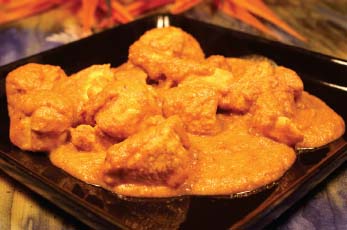
▪ Heat the oil in a large, heavy-based frying pan and add the cumin, coriander and cardamom and fry for a few seconds. Add the curry sauce and bring to a boil.
▪ Stir in the chili powder, paprika (if you are using it) and salt. Simmer for about 5 minutes and stir in the cream and ground nuts.
▪ Simmer for another 5 minutes and stir in the chicken. Continue to cook on low heat for another 5 minutes, stirring often. Serve.
This delicious and unusual chicken curry is thought to originate on the southwest coast of India. It has distinct Goan and south Indian influences. The chickpeas and mushrooms make this curry almost a one-pot dish that is tasty, satisfying and nutritious.
▪ Heat the oil in a deep, heavy-based frying pan and add the mustard seeds. Shake the pan over the heat for a few seconds until the seeds start to pop, and add the garlic, ginger and mushrooms.
▪ Stir-fry for 3 minutes and add the bay leaves, cinnamon, cardamoms, coriander, cumin, chili and turmeric. Fry for a minute and stir in the chickpeas, curry sauce, paprika and salt.
▪ Bring to a boil, and cook on high for 5 minutes until the sauce thickens. Add the chicken and coconut milk, bring back to a boil and simmer for 10 minutes.
▪ Stir through the red chili and serve sprinkled with cilantro.
Chettinad, a prosperous region in Tamil Nadu, southern India, is renowned for its spice concoctions. Historically a trading region, spices were one of the main commodities traded. It is thought that this is why there is such an abundant use of spices in its cuisine. Therefore, this recipe does require a number of different spices, but once you smell the beautiful aroma of the roasted spices, I think you will feel it’s worth it. Fresh coconut will produce the best results, but dried, shredded coconut is fine.
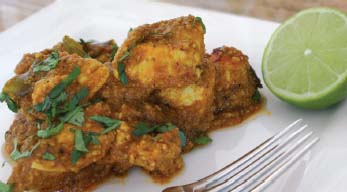
▪ Heat the oil in a small pan and roast the spices and coconut on low heat for about a minute until aromatic. Cool and grind to a fine powder in a pestle and mortar or electric grinder.
▪ Heat the remaining oil in a large, heavy-based frying pan and add the curry leaves, stir for a few seconds and add the chopped tomato. Stir-fry for 3 or 4 minutes until pulpy and add the spice mix. Fry on low heat for about 5 minutes, until the mixture starts releasing the oil.
▪ Add the curry sauce, salt, chili powder, paprika and turmeric and bring to a boil. Simmer for about 5 minutes. The sauce will be quite thick because of the spice mix. Add a little water if required.
▪ Add the chicken, bring back to a simmer and cook for 3 minutes. Stir in the tomatoes, lime juice and cilantro, and serve.
This is absolutely delicious and so simple and quick to prepare. It is essential to use fresh herbs though; they are the backbone of this spectacular dish. Curry sauce is not required for this dish.
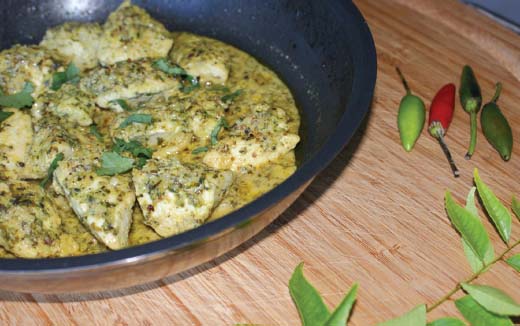
▪ Wash the chicken fillets, pat dry with paper towels, and cut into 1-inch (2.5 cm) chunks. Place in a large bowl.
▪ Put the salt, herbs, spring onions, chilies, ginger, garlic, garam masala, yogurt and 1 tablespoon of the oil into the blender or food processor and process to a paste.
▪ Add the herb paste to the chicken, mix well and refrigerate for 2–3 hours or overnight.
▪ Remove from the fridge about half an hour before cooking and stir in the cream and chickpea flour.
▪ Heat a wide, heavy-based (preferably nonstick) frying pan and add the remaining oil. Add the chicken and all the marinade to the pan and stir-fry on high heat until the chicken is opaque.
▪ Turn down the heat a little, and continue to cook, stirring and turning the chicken pieces, until the sauce is quite dry, at which point it will release the oil (about 6–7 minutes).
▪ Continue cooking for a few minutes longer until the chicken pieces start to brown slightly. Now add the water and stir in to create a thick, creamy sauce.
▪ Simmer gently for 3 or 4 minutes. Add more water if you want a little more sauce.
▪ Serve.
Note: The chickpea flour is important as it prevents the sauce from spitting.
No Indian restaurant cookbook could be complete without a recipe for the famous Chicken Tikka Masala.
Chicken Tikka Masala is probably, more than any other restaurant dish, a hybrid of Indian and Western tastes: tikka is a morsel of roasted meat, traditionally eaten without curry sauce or gravy, a practice seemingly unattractive to Western palates. The masala part of the dish is the Western touch that possibly came about in Glasgow in the 1960s when a long-suffering Indian chef mixed some spices and yogurt into canned tomato soup and presented his ever-complaining customers with the sauce they demanded. The rest, as they say, is history.
With a few enhancements since that fateful time, the dish has become an icon of Indian restaurant cuisine. Indeed, in 2001, Britain’s foreign minister Robin Cook declared it to be Britain’s “national dish” and the British consume vast amounts of it each week. It is, in fact, even more popular than fish and chips.
There are many recipes for Chicken Tikka Masala. This one is easy to prepare and quite delicious.
▪ Heat the oil in a large, deep frying pan, and stir in the cumin. Fry for a few seconds and add the curry sauce. Bring the sauce to a boil.
▪ Add the paprika, salt, chili powder and food coloring (if you are using it), and continue to cook on high heat, stirring frequently, for about 5 minutes or until the sauce thickens.
▪ Turn down the heat and stir in the garam masala. Simmer for about 3 minutes.
▪ Meanwhile, slice each piece of chicken tikka in two and add to the sauce. Stir in the cream and simmer for another 2–3 minutes.
▪ Serve sprinkled with the cilantro.
TIP
If you have a little Tandoori Marinade (page 57) left over, stir a couple of teaspoons of it into the sauce just before the cream. It adds extra color and flavor.
This delicious Parsi dish has a lovely balance of sweet and sour flavors derived from juicy apricots, soft brown sugar and vinegar. Lamb can be used instead of chicken for a change.
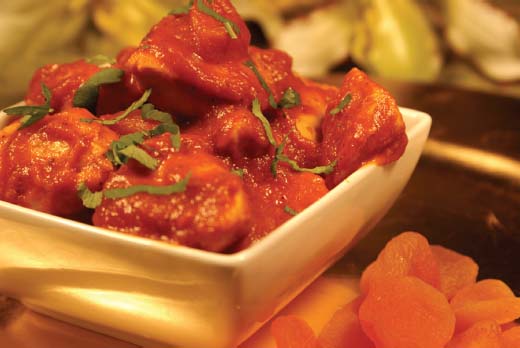
▪ Heat the oil in a large, heavy-based frying pan and add the tomato paste and turmeric. Stir-fry for a minute.
▪ Add the curry sauce, salt, chili powder, paprika, apricots, sugar and vinegar. Bring to a boil and simmer for 5 minutes.
▪ Stir in the chicken, bring back to a boil and simmer, stirring often, for 5 minutes.
▪ Stir in the cream and garam masala. Simmer for a minute. Serve sprinkled with cilantro.
Nowhere is the Portuguese influence more evident than in the delicious and colorful cuisine of Goa. Although seafood and rice are the staples, this chicken recipe encompasses all that is good about Goan food. It has lots of tasty sauce to eat with rice and bread.
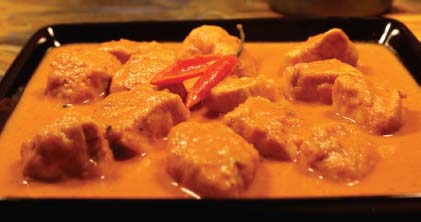
▪ Grind all the spices for the spice mix to a fine powder in a pestle and mortar or electric grinder.
▪ Heat the oil in a large, heavy-based frying pan and add the spice mix. Fry on medium heat for about a minute until aromatic.
▪ Stir in the turmeric, curry sauce, salt, chili powder and paprika. Bring to a boil and cook on high heat for about 3 minutes until thickened slightly. Turn down the heat.
▪ Add the coconut cream and bring slowly to a simmer. Add the chicken to the sauce and mix well. Simmer for about 5 minutes.
▪ Stir in the tamarind and serve.